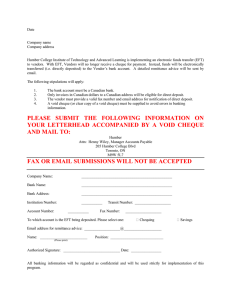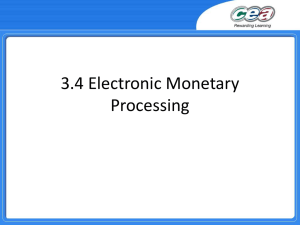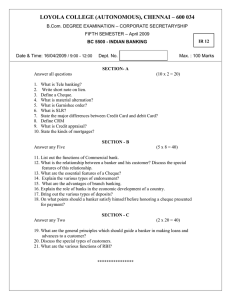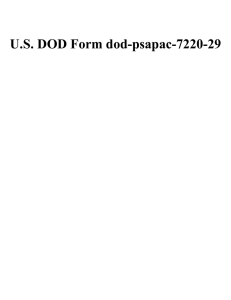Electronic Banking Methods: ATMs, EFT, EFTPOS, Online & More
advertisement
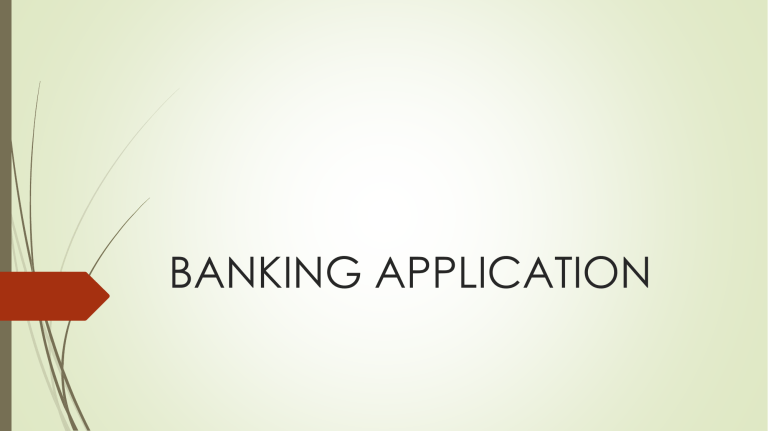
BANKING APPLICATION Using Cash Machines (ATMs) ATMs can be used to for a range of banking services... • Withdrawing cash • Depositing money • Checking the balance of accounts • Transferring money between accounts • Paying bills A customer identifies him/herself and their bank account by using a bank card. The card is inserted into the ATM where it is read by a magnetic strip reader or a smart card reader. The customer also types a secret PIN into the ATM's numeric keypad to confirm that they are the real owner of the card ATMs can be used by customers of other banks as the ATM can use EFT... If • • • a customer of Bank A uses her debit card to withdraw cash from an ATM` belonging to Bank B: Bank B gives her the cash Bank B now is owed money by Bank A Bank B sends an EFT instruction to Bank A asking for money to be transferred from the customer’s account to Bank B. • Bank B has now been paid back Electronic Fund Transfer (EFT) EFT is a system that allows money transfer instructions to be sent directly to a bank’s computer system. Upon receiving one of these instructions, the computer system automatically transfers the specified amount from one account to another. Transfer instructions can come from other banks or from businesses. A very common use of EFT is when a large business pays its employees’ salaries. On pay day, the businesses tells the bank to move money from the business account to the employees’ bank accounts... Handling Electronic Payments (EFTPOS) When you use a bank card to pay for a purchase in a store, the payment is made using a system called Electronic Fund Transfer at Point-of-Sale (EFTPOS). Customer gives the bank card to the cashier The cashier runs the card through a card reader (the customer may have to enter a PIN). The cashier enters the value of the purchase The store’s system then connects to the bank computer and sends a message The bank computer uses the account number to access the customer’s record and checks the balance Handling Electronic Payments (EFTPOS) The bank computer sends back a confirmation or rejection message to the store’s system The cashier now confirms the purchase and an EFT message is sent to the bank The bank computer subtracts $100 from the customer’s account and adds $100 to the store’s account The cashier gives the card back to the customer along with a receipt Online banking Customers use a computer and connect to the bank’s secure (encrypted) website where they login (usually with a username and a password) Customers can use the on-line banking system to... • • • • Check the balance of bank accounts Pay bills Transfer money between accounts (using EFT) Apply for loans, or other services Telephone Banking The system works by you calling the bank's telephone banking number then... • You enter your account number (using the phone's number keys) • You enter your PIN / secret code • You then hear various options: ("Press 1 to find your balance, Press 2 to transfer money...") • You pick an option (using the phone's number keys) Customers can use the telephone banking system to... • Check the balance of bank accounts • Pay bills • Transfer money between accounts (using EFT) • Speak to a bank representative to get financial advice Processig Cheques (Cheque 'Clearing‘) To help speed things up, a special system of printing is used on cheques that can be read by a reader connected to the computer system. At the bottom of every cheque, printed in a special font using magnetic ink, is the bank account number and cheque number: Processig Cheques (Cheque 'Clearing‘) Processig Cheques (Cheque 'Clearing‘)
